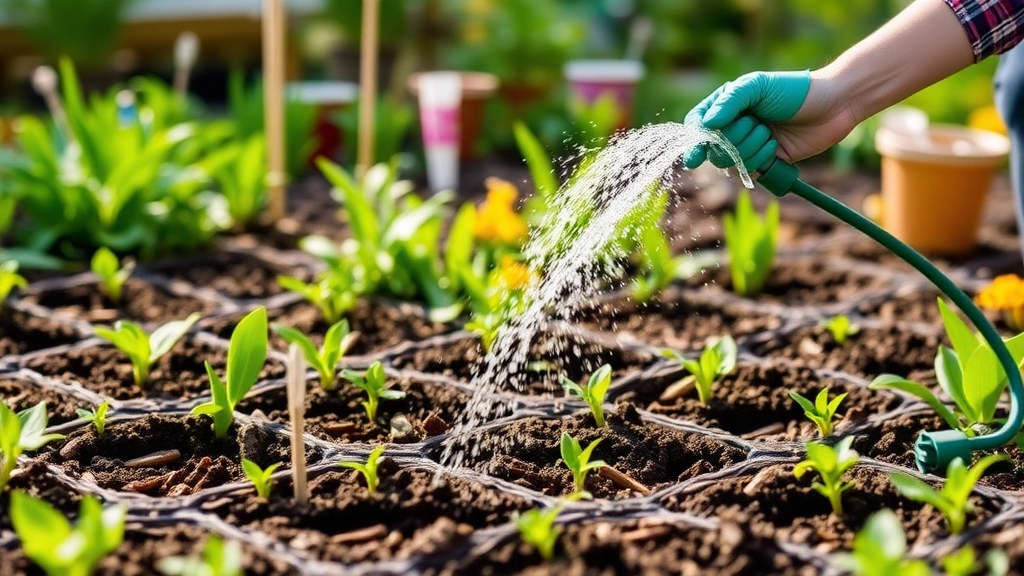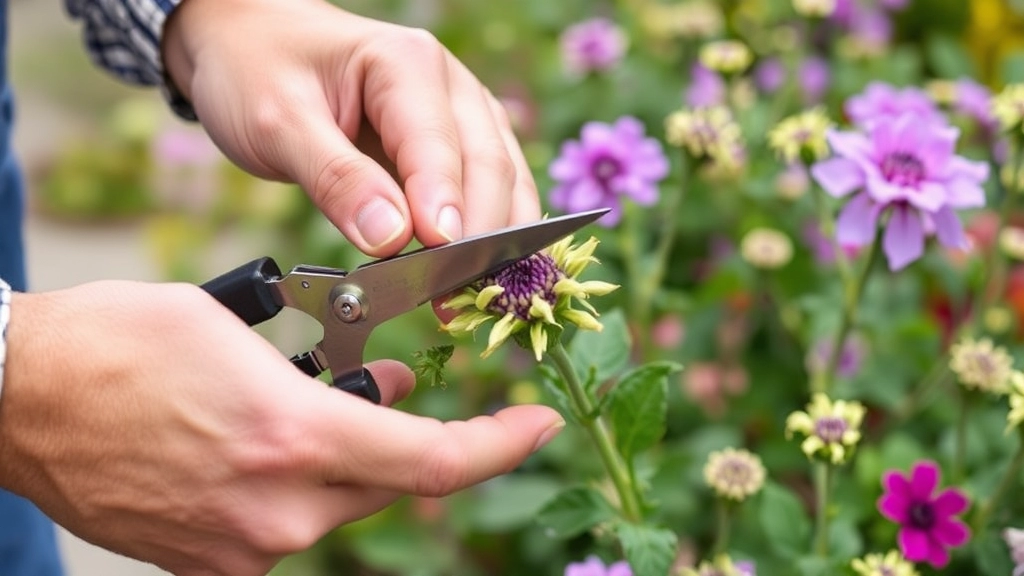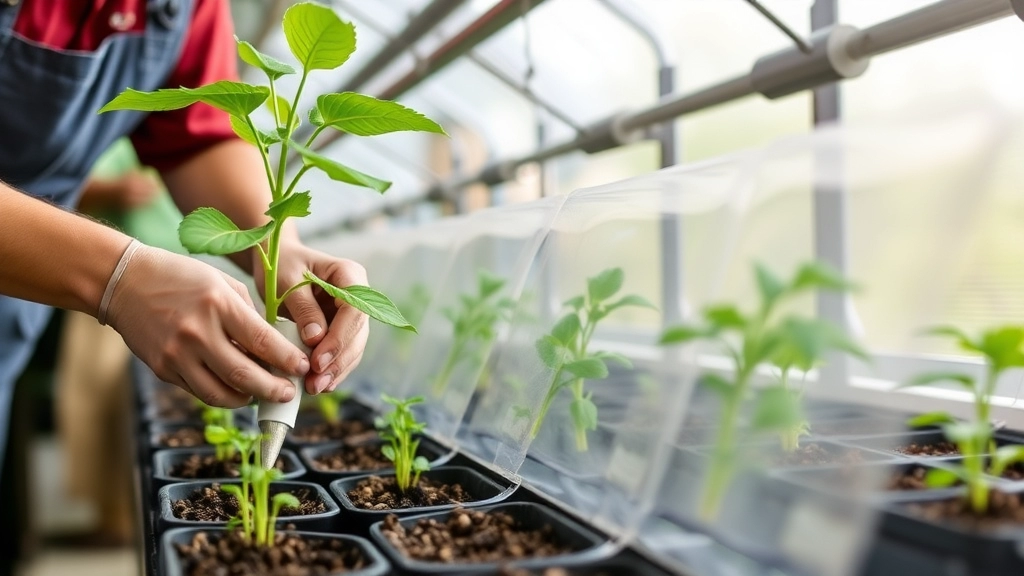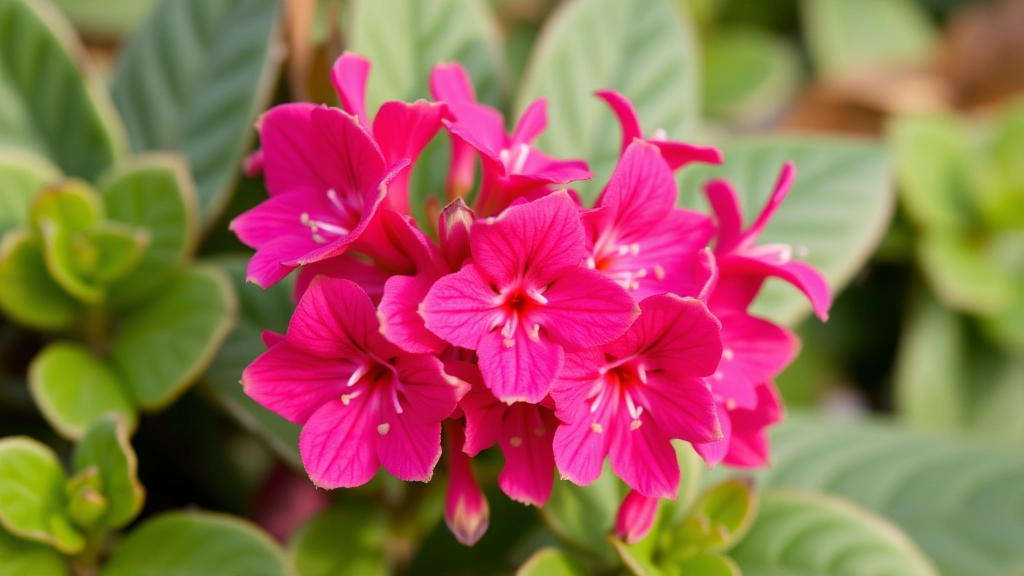Welcome, plant enthusiasts!
As an avid gardener and Kalanchoe lover, I’m thrilled to share my insights on caring for the stunning Kalanchoe blossfeldiana Poelln. This vibrant succulent, known for its colorful blooms and easy-care nature, has become a favorite among indoor gardeners. In this article, we’ll explore essential care tips, from light and water requirements to soil preferences and common issues.
Whether you’re a seasoned plant parent or a newbie looking to add some floral flair to your space, you’ll find valuable information here. We’ll cover everything from optimal growing conditions to troubleshooting techniques, ensuring your Kalanchoe thrives year-round. So, let’s dive in and unlock the secrets to keeping your Kalanchoe blossfeldiana Poelln happy and healthy!
Light Requirements for Kalanchoe Blossfeldiana
Hey there, plant pals! Let’s chat about Kalanchoe blossfeldiana’s light needs.
These succulents are sun-lovers, but they’re not beach bums.
They thrive in bright, indirect light. Think of it as the Goldilocks zone – not too much, not too little.
Here’s the lowdown:
- Aim for 4-6 hours of bright, indirect sunlight daily
- Morning sun is ideal, afternoon rays can be a bit harsh
- South or west-facing windows are your best bet
But wait, there’s more:
- Too little light? Your Kalanchoe might get leggy and refuse to bloom
- Too much direct sun? You’ll see scorched leaves. Ouch!
Pro tip: If you’re in the UK, where sunny days can be rare, consider a grow light for winter months.
Remember, Kalanchoe blossfeldiana is all about that light balance. Get it right, and you’ll be rewarded with a stunning display of blooms.
So, ready to light up your Kalanchoe’s life? Let’s get growing!
Optimal Watering Practices

Alright, let’s dive into watering your Kalanchoe Blossfeldiana. Trust me, this isn’t rocket science, but it’s crucial to get it right.
Here’s the deal: These succulents are pretty chill when it comes to water. They’re not thirsty drama queens like some other plants (looking at you, ferns).
The Golden Rule
Less is more. Seriously.
Why? Because these bad boys store water in their thick leaves. Overwatering is like force-feeding your mate at an all-you-can-eat buffet. It’s not gonna end well.
So, how often should you water? Here’s my tried-and-true method:
- Stick your finger about an inch into the soil.
- If it’s dry, give it a drink.
- If it’s still moist, leave it be.
Simple, right?
But wait, there’s more:
- Water deeply when you do water. Don’t just sprinkle the top like you’re seasoning a steak.
- Let excess water drain out. No one likes wet feet, including your Kalanchoe.
- In winter, cut back even more. These plants go into a bit of a snooze mode.
Now, here’s a pro tip: Use room temperature water. Cold water’s a shock to the system, like jumping into a freezing pool. Not fun.
Remember, it’s easier to save an underwatered Kalanchoe than an overwatered one. If you’re ever in doubt, err on the dry side.
Bottom line: Watering your Kalanchoe Blossfeldiana succulent doesn’t have to be a headache. Keep it simple, keep it dry(ish), and you’ll be golden. If you’re interested in propagation, you might want to check out how to grow Kalanchoe Blossfeldiana from cuttings for even more plants.
Soil and Potting Mix Recommendations
Alright, let’s talk soil for your Kalanchoe Blossfeldiana. This is crucial stuff.
You want a mix that drains well but still holds some moisture. Why? These succulents hate wet feet.
Here’s what I’ve found works best:
- 2 parts regular potting soil
- 1 part perlite or coarse sand
- 1 part orchid bark or small pebbles
This combo gives you that perfect balance. Not too wet, not too dry.
Now, here’s a pro tip: add a layer of gravel at the bottom of your pot.
It helps with drainage and stops the soil from getting waterlogged.
But wait, there’s more. The pH level matters too.
Kalanchoes like it slightly acidic to neutral. We’re talking 6.0 to 6.5 pH.
If you’re not sure about your soil’s pH, grab a testing kit from your local garden centre.
Remember, the right soil can make or break your Kalanchoe’s health.
Get this right, and you’re halfway to having a thriving, blooming beauty.
Any questions about soil for your Kalanchoe? Hit me up. I’m always happy to chat plants.
Ideal Temperature and Humidity Levels

Let’s talk about keeping your Kalanchoe Blossfeldiana happy with the right temperature and humidity. Trust me, I’ve learned this the hard way, and I’m here to save you from my mistakes.
Temperature Sweet Spot
These succulents are pretty chill (pun intended) when it comes to temperature. They’re not drama queens like some other plants I’ve dealt with. Here’s the deal:
- Daytime: Aim for 60-85°F (15-29°C)
- Nighttime: They can handle a slight dip, but try to keep it above 50°F (10°C)
Heads up: If you’re growing these beauties outdoors, bring them in when it gets chilly. They’re not fans of frost, and trust me, you don’t want to see a sad, frozen Kalanchoe.
Humidity Hacks
Now, humidity is where things get interesting. These plants are like that friend who’s always comfortable, no matter the weather. They’re not fussy about humidity, but there are a few tricks to keep them thriving:
- Average room humidity is usually fine
- If your place is super dry (looking at you, desert dwellers), a light misting now and then won’t hurt
- Avoid placing them near air vents or radiators – they’ll dry out faster than my bank account on payday
Pro tip: If you’re worried about humidity, group your Kalanchoe with other plants. It’s like a little plant party, and they’ll create their own mini-ecosystem.
Temperature Troubles?
If your Kalanchoe is looking a bit off, temperature might be the culprit:
- Droopy leaves? Might be too cold
- Crispy edges? Could be too hot or dry
Remember, these plants are tough cookies, but they’re not invincible. Keep an eye on them, and they’ll let you know if something’s not right.
Bottom line: Kalanchoe Blossfeldiana, like other succulents, likes it comfy – not too hot, not too cold, and not too fussy about humidity. Stick to these guidelines, and you’ll have a happy, blooming plant that’ll make your friends green with envy.
Fertilizing Kalanchoe Blossfeldiana
Hey, let’s talk about feeding your Kalanchoe Blossfeldiana.
It’s not rocket science, but get it right and your plant will thank you.
First off, these guys aren’t big eaters. Don’t go overboard.
Here’s the deal:
- During growing season (spring and summer), feed every 2-4 weeks
- Use a balanced, water-soluble fertilizer
- Dilute it to half strength – these plants are sensitive
Now, here’s a pro tip:
Stop fertilizing in autumn and winter. Your Kalanchoe’s taking a break.
Common mistake? Over-fertilizing.
Signs you’re doing too much:
- Leaf burn
- Stunted growth
- Wilting
Remember, less is more with these beauties.
Got questions about your plant’s health? Check the leaves.
Yellow leaves might mean you’re overdoing it with the food.
Bottom line: Kalanchoe Blossfeldiana doesn’t need much fertilizer to thrive.
Keep it simple, stick to the schedule, and your plant will be happy as Larry.
Pruning and Deadheading Techniques

Alright, let’s talk about keeping your Kalanchoe Blossfeldiana looking sharp. Trust me, a bit of pruning and deadheading can work wonders for these beauties.
Why bother with pruning?
Simple. It’s like giving your plant a haircut. You’re not just making it look good; you’re helping it grow better. Here’s the deal:
- Pruning encourages bushier growth
- It helps maintain the plant’s shape
- Removes any dead or diseased parts
When to prune?
I usually go for it after the flowering period. That’s when the plant’s taking a breather and can handle a trim.
How to prune Kalanchoe Blossfeldiana:
- Grab some clean, sharp scissors or pruning shears
- Cut back stems to about 10 cm (4 inches) above the soil
- Make cuts just above a leaf node (where leaves meet the stem)
- Remove any dead, yellowing, or damaged Kalanchoe Blossfeldiana leaves
Deadheading: What’s the fuss?
Deadheading is just a fancy word for removing spent flowers. It’s not just about looks; it’s about keeping your plant healthy and blooming.
Benefits of deadheading:
- Encourages more blooms
- Prevents seed formation (saves energy for the plant)
- Keeps the plant looking tidy
How to deadhead:
- Pinch off faded flowers with your fingers
- Or use scissors to cut the flower stem back to the first set of leaves
Pro tip: If you’re after a bushier plant, pinch off the growing tips of young stems. It’s like telling your Kalanchoe to branch out more.
Remember, pruning and deadheading aren’t just chores. They’re your chance to get up close and personal with your plant. It’s when you spot any potential issues early on.
So, next time you’re giving your Kalanchoe Blossfeldiana a trim, think of it as a spa day for your plant. You’re not just pruning; you’re pampering. And trust me, your plant will thank you with more blooms and healthier growth.
Common Pests and Diseases
Hey, let’s chat about the bugbears that might mess with your Kalanchoe Blossfeldiana, yeah?
These little suckers can be a real pain, but don’t sweat it – I’ve got your back.
First up, the usual suspects:
- Mealybugs – these cottony pests love to party on your plant
- Spider mites – tiny terrors that can do big damage
- Aphids – small but mighty plant vampires
Now, diseases:
- Root rot – the silent killer lurking beneath the soil
- Powdery mildew – looks like your plant’s been dusted with flour
Here’s the deal: prevention is your best mate.
Keep your Kalanchoe happy and healthy, and it’ll fight off most nasties on its own.
But if trouble strikes, act fast.
For pests, a good spray down with neem oil usually does the trick.
Diseases? Often it’s about adjusting your care routine.
Too much water? That’s a one-way ticket to root rot city.
Remember, a stressed plant is a vulnerable plant.
So keep an eye out, give your Kalanchoe some love, and you’ll nip most problems in the bud.
Trust me, dealing with Kalanchoe pests and diseases isn’t rocket science – just a bit of know-how and quick action.
Propagation Methods

Alright, let’s talk about how to make more of these beauties. Propagating Kalanchoe Blossfeldiana isn’t rocket science, but it’s pretty darn satisfying when you get it right.
Leaf Cuttings: The Easy Way
Here’s how I do it:
- Snip a healthy leaf from the plant
- Let it dry out for a day or two (this helps prevent rotting)
- Stick it in some well-draining soil
- Keep it moist but not soggy
- Wait for the magic to happen
It’s like watching paint dry, but way more exciting. In a few weeks, you’ll see tiny plantlets popping up at the base of the leaf.
Stem Cuttings: For the Overachievers
If you’re feeling a bit more adventurous, try stem cuttings for Kalanchoe Blossfeldiana:
- Cut a 3-4 inch stem with a few leaves
- Remove the lower leaves
- Let it callous over for a day
- Plant it in moist soil
- Keep it warm and humid
Pro tip: Use a clear plastic bag to create a mini greenhouse effect. It’s like giving your cutting a cozy little sauna.
Division: The Crowd Pleaser
Got a big, bushy Kalanchoe? Here’s how to spread the love:
- Gently remove the plant from its pot
- Shake off excess soil
- Carefully separate the roots into smaller clumps
- Replant each section in its own pot
It’s like giving your plant a haircut and a new home all at once.
Seeds: For the Patient Ones
I’ll be honest, I rarely bother with Kalanchoe Blossfeldiana seeds. It’s slow and finicky. But if you’re up for a challenge:
- Collect seeds from spent flowers
- Sow them on the surface of moist soil
- Cover the container with plastic wrap
- Keep it warm and bright (but not direct sun)
- Wait… and wait some more
It’s a bit like watching grass grow, but with more excitement at the end.
Remember, no matter which method you choose, patience is key. Kalanchoe Blossfeldiana isn’t known for its speedy propagation. But trust me, when those new plants start thriving, it’s worth every second of the wait.
Seasonal Care Tips for Kalanchoe Blossfeldiana
Hey there, plant pals! Let’s chat about keeping your Kalanchoe happy all year round.
Spring: Time to Wake Up!
As the days get longer, your Kalanchoe’s ready to party.
- Move it to a brighter spot, but ease into it. No sunburns, please!
- Start fertilizing again, but go easy at first.
- Check for any winter damage and trim as needed.
Summer: Livin’ Easy
This is when your Kalanchoe’s living its best life.
- Water more often, but don’t drown it.
- Keep an eye out for pests – they love the warm weather too.
- If it’s scorching hot, give it some afternoon shade.
Autumn: Prepping for Winter
Time to help your plant wind down.
- Cut back on watering and fertilizer.
- Move it to a cooler spot to encourage blooming.
- Consider propagating if you want more plants.
Winter: Chill Time
Your Kalanchoe’s taking it easy now.
- Water sparingly – only when the soil’s bone dry.
- Keep it away from cold drafts and radiators.
- Enjoy the blooms! This is its time to shine.
Remember, Kalanchoe Blossfeldiana care isn’t rocket science. Just keep an eye on the seasons and adjust accordingly. Your plant will thank you with gorgeous blooms!
Troubleshooting Common Problems
Let’s face it, even the toughest Kalanchoe Blossfeldiana can hit a rough patch. But don’t sweat it! I’ve been there, done that, and I’m here to help you troubleshoot those pesky problems.
Yellowing Leaves: The Silent SOS
Ever walked up to your Kalanchoe and thought, “Mate, why so yellow?” Here’s the deal:
- Overwatering: Yep, too much love can drown ’em. Let the soil dry out between waterings.
- Nutrient deficiency: Your plant might be crying out for a snack. Try a balanced fertiliser.
- Sunburn: Too much direct sun can fry those leaves. Move it to a spot with bright, indirect light.
Flower Power Failure
No blooms? Don’t panic! Here’s what might be up:
- Light issues: These guys need about 14 hours of darkness daily to trigger flowering. Try popping them in a dark closet overnight.
- Temperature troubles: Keep ’em between 15-21°C (60-70°F) for happy blooms.
- Overfertilising: Ease up on the plant food, champ. Too much can lead to all leaves, no flowers.
Droopy Drama
If your Kalanchoe’s looking a bit down in the dumps:
- Check the soil: Is it bone dry or sopping wet? Either extreme can cause drooping.
- Temperature shock: Sudden changes can stress ’em out. Keep ’em cosy and consistent.
- Root rot: If the stems are mushy, you might have a rot problem. Time for some root surgery!
Pest Party Crashers
Uninvited guests? Let’s show ’em the door:
- Mealybugs: These cottony pests can be wiped off with rubbing alcohol.
- Spider mites: A good shower and some neem oil should do the trick.
- Aphids: Blast ’em off with water or use insecticidal soap.
Remember, troubleshooting Kalanchoe Blossfeldiana problems is all about observation and quick action. Keep an eye on your plant, and you’ll catch issues before they become disasters. And hey, don’t be afraid to get your hands dirty – sometimes, a little TLC is all your Kalanchoe needs to bounce back!
Frequently Asked Questions about Kalanchoe Blossfeldiana Care
How often should I water my Kalanchoe Blossfeldiana?
Water your Kalanchoe when the top inch of soil feels dry. Typically, this means watering once every 1-2 weeks, but it can vary based on your environment. Remember, it’s better to underwater than overwater these succulents.
Why isn’t my Kalanchoe blooming?
Kalanchoes need a period of darkness (about 14 hours) each day for several weeks to trigger blooming. If your plant isn’t flowering, try placing it in a dark room or closet overnight for a few weeks. Also, ensure it’s getting enough bright, indirect light during the day.
Can I grow Kalanchoe Blossfeldiana outdoors?
Yes, you can grow Kalanchoe outdoors in USDA zones 10-11. In cooler climates, it’s best to keep them as indoor plants or move them outside only during warm months. Always protect them from frost and extreme heat.
How do I propagate my Kalanchoe?
Kalanchoe Blossfeldiana can be propagated through leaf or stem cuttings. Allow the cutting to callous over for a day or two, then plant it in well-draining soil. Keep the soil slightly moist until roots develop.
What type of soil is best for Kalanchoe Blossfeldiana?
Use a well-draining potting mix designed for succulents or cacti. You can also make your own by mixing regular potting soil with perlite or coarse sand to improve drainage.
How often should I fertilize my Kalanchoe?
Fertilize your Kalanchoe every 2-4 weeks during the growing season (spring and summer) with a balanced, water-soluble fertilizer diluted to half strength. Stop fertilizing in fall and winter when the plant’s growth slows.
Why are my Kalanchoe’s leaves turning yellow?
Yellowing leaves can be caused by overwatering, poor drainage, or nutrient deficiencies. Check your watering habits first, ensure the pot has drainage holes, and consider fertilizing if you haven’t in a while.
How do I prune my Kalanchoe Blossfeldiana?
Prune after flowering to encourage bushier growth. Cut back stems to about 10 cm (4 inches) above the soil, making cuts just above a leaf node. Remove any dead or yellowing leaves as well.
References
-
Missouri Botanical Garden – Kalanchoe blossfeldiana Kalanchoe blossfeldiana

